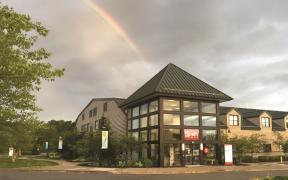People may experience burns while doing daily activities such as cooking or drinking hot liquids. To prevent burns, be sure to use caution around hot objects.
What are burns?
Burns are damage to the skin and possibly deep tissue from heat, electricity, chemicals, sun or radiation. Burns are areas of red, swollen and painful skin and can be a serious medical concern if they are severe. Burns are placed into categories based on how deep they are. Doctors use 2 different systems to describe burns: the “degree” of the burn and a description based on depth.
- A superficial (first degree) burn is red, dry, painful, and blanches (turns white) when pressure is applied. A sunburn is an example of a superficial burn.
- A superficial partial thickness (superficial second degree) burn is red, painful, and moist with blisters; it blanches with pressure
- A deep partial thickness (deep second degree) burn is white or red, does not blanch with pressure, and is often not painful (because the nerves of the skin that perceive pain have been destroyed).
- Full thickness (third degree) and fourth degree burns are very severe and involve the deep layers of the skin, fascial tissue or muscle.
Minor and major burns all need treatment, but major burns should be looked at by a doctor immediately. Call 911 or go to the emergency department if you have a major burn.
What causes burns?
Unsafe habits near stoves, chemicals and electrical sockets can put anyone at risk for burns. Be sure to keep children from stoves, irons and ovens. Many people experience burns while cooking, eating or being near an open flame. These burns can be minor or major and need medical attention. Other burns can come from:
- Touching hot objects, liquids or steam
- Contact with flame
- Overexposure from the sun
- Chemicals
- Electricity
- Smoking, especially patients who continue to smoke despite being on home oxygen
What are the symptoms of a burn?
Symptoms depend on how large the burn is, and how deep the burn is in the skin. Symptoms from burns may include:
- Peeling skin
- Swelling
- Red, white or charred skin
- Shock
Burned airways can cause:
- Difficulty breathing
- Coughing
- Dark mucus
- Voice changes
- Wheezing
Call 911 and lay flat if you believe you or someone you know may have burned the lungs or airways.
When to seek medical attention
Major burns need immediate medical treatment. If you have a major burn, call 911, or go to the nearest emergency department. If someone has trouble breathing, has a burn caused by electricity or chemicals, or has a burn larger than the size of their palm, call 911.
Most minor burns can be treated without attention. However, you should seek medical care for burns of the face or hands, burns that involve joints (such as elbows or knees), and burns of the genitals. Proper care can help prevent infection and heal quicker. Call your doctor if an infection occurs after being burned.
Healing takes time
Burns heal differently depending on the severity. Healing can take from three to six days for first-degree burn, up to three weeks for second-degree burns, and months for a third-degree burn.
Third-degree burns often require skin grafts. Skin grafts are pieces of skin from one healthy location on the body transferred to the damaged area to increase healing. This can often take a while to recover, especially when there are two or more areas that need to heal.
Be sure to follow your doctor’s direction in caring for you burn. Call your doctor if you have any questions or if you are unsure about anything.


















